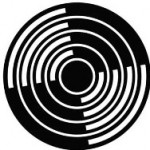I’ve deleted my last two posts on this subject, combined them and added something new, so that in this post everything’s finally all together. When I saw the first crop circle of 2009, I immediately noticed its similarity to an important formation in North Dakota in 2000. As stated in one of my prior articles, peculiar echoes from the Thompson formation of 2000 are evident in the Ridgeway formation of 2009…and I’d like to know why.
For comparison and contrast, three images accompany this post:
- My diagram of the Thompson, ND, United States, “Circle in Parentheses,” of late summer 2000
- Andreas Muller’s diagram of the 2009 Ridgeway formation near Avebury
- Peter Sorensen’s uncorrected photography of the 2009 Ridgeway formation
What I intend to argue is that the much-acclaimed Ridgeway Waveguide appears to carry on a theme that started with the little-known Thompson formation nearly a decade ago. If any doubt remains that the crop circles are somehow related, the “error” in one of the Ridgeway arcs (corrected in Andreas’ diagram and in Peter’s PhotoShopped stills, not shown here) hints that the tapered arc is not only intentional, but may even be a radical point (no pun intended) – and thus, it shouldn’t be disregarded as a mere mistake.
1) My Thompson diagram is a bit rough-looking, but accurate.  Extensive ground measurements and compass bearings taken throughout this large, if simple, formation, show the circle hugged by two arcs – three of the ends perpendicular, and one tapered. I followed the tapered arc with dowsing rods, and was strongly guided toward the inner circle, where between the taper and the circle in the stubbled wheatfield (which had been harvested without any media hoopla) was a beautifully swirled grapeshot, probably no more than 18 inches in diameter. The Thompson formation was significantly larger than the Ridgeway formation, though less intricate – and the firmly pressed wheat left no question that the taper was indeed part of the design.
Extensive ground measurements and compass bearings taken throughout this large, if simple, formation, show the circle hugged by two arcs – three of the ends perpendicular, and one tapered. I followed the tapered arc with dowsing rods, and was strongly guided toward the inner circle, where between the taper and the circle in the stubbled wheatfield (which had been harvested without any media hoopla) was a beautifully swirled grapeshot, probably no more than 18 inches in diameter. The Thompson formation was significantly larger than the Ridgeway formation, though less intricate – and the firmly pressed wheat left no question that the taper was indeed part of the design.
2) Andreas Muller’s diagram of the 2009 Ridgeway formation is enchanting. (Reproduced with permission. See Andreas’ website at http://www.cropcirclescience.org.) The design really does seem to reference a waveguide, as Simeon Hein (www.newcrystalmind.com) pointed out when he reported on the first crop circle of the 2009 season. The diagram, although preliminary, probably won’t be changed much, if at all, due to its aesthetic appeal as is – although I’d like to see the tapered arc that we can confirm was there, as seen in Peter Sorensen’s unretouched stills of the Ridgeway formation – next:
3) Here’s one of Peter’s “raw” stills, with which I’ve taken the liberty to enhance the contrast in order to better show the tapered arc that Peter edited out of his final photographic versions of the Ridgeway crop circle, which can be seen at his website: http://cropcircleconnector.com/Sorensen/PeterSorensen99.html. Quoting Peter from personal correspondence, “The picture I sent around to be posted on my web page yesterday did NOT show the detail you were interested in, because (as I so often do) I had fixed what we circlemakers would call an error — the crooked end of the arc.” (Despite the heightened contrast, the tapered arc is still somewhat difficult to see – in part due to the shot’s angle as well as the flowering rapeseed in which the Ridgeway formation appeared. In this photo, it’s in the arc nearest the inner circle on the right side. Nick Nicholson’s image, available in the 2009 archives via membership at the Crop Circle Connector website, more clearly shows the remarkable similarity – with the taper clearly opposing the expected geometry, exactly as in the Thompson formation.)
What I’ve noticed from my 14 years of crop circle studies is that all the formations that have resonated most strongly with me have been touched by some kind of “magic.” These clues range from instantaneous healing, as in the Bishops Cannings formation, to amazing synchronicities interwoven on many levels of experience over time, as with the Inman, Kansas formation and the three North Dakota formations (of which Thompson was one).
Unless it’s just a simple coincidence that both formations show very similar geometry (to start with, simply put an “X” through the inner circle to find the ends of all the arcs) as well as what I consider a very-telling “error,” i.e., the tapered arc in both formations, then we must consider these surface aspects to be intentional and therefore something to be included in any serious contemplation of the phenomenon’s deeper implications.
STACE TUSSEL
My article “More Crop Circle Synchronicities – North Dakota, 2000” details that entire whirlwind expedition to Langdon and Thompson, ND, fraught with wild synchronicities and enigmatic clues. If you’d like to more fully appreciate my fascination with the Ridgeway Waveguide, please take time to read that post.


